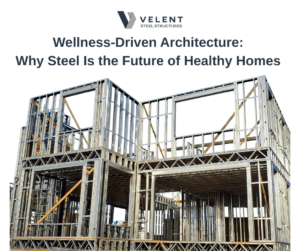In the evolving landscape of residential construction, the focus is shifting beyond aesthetics and durability to encompass the health and well-being of occupants. Steel framing, traditionally lauded for its strength and longevity, is now gaining recognition for its contributions to healthier living environments. This blog delves into the health benefits of steel-framed homes, highlighting why this construction method is becoming a preferred choice for health-conscious homeowners.

-
Superior Resistance to Mold and Mildew
Unlike wood, steel is inorganic and does not absorb moisture, making it impervious to mold and mildew growth. This resistance is crucial in maintaining indoor air quality, as mold spores can trigger allergic reactions and respiratory issues. By eliminating a primary source of mold proliferation, steel framing contributes to a healthier indoor environment.
-
Pest-Free Living
Steel framing offers a formidable defense against pests such as termites, rodents, and insects. These pests not only compromise structural integrity but also pose health risks through allergens and disease transmission. The non-organic nature of steel denies pests a food source, reducing the likelihood of infestations and the need for chemical pest control treatments.
-
Enhanced Fire Safety
Steel’s non-combustible properties provide an added layer of fire safety. In the event of a fire, steel framing does not contribute to the spread of flames, offering occupants more time to evacuate and reducing the release of harmful smoke and gases. This characteristic not only safeguards lives but also minimizes potential health hazards associated with fire incidents.
-
Improved Indoor Air Quality
The precision of steel framing allows for tighter construction, reducing gaps and crevices where allergens and pollutants can infiltrate. Additionally, steel does not emit volatile organic compounds (VOCs), which are commonly found in some wood treatments and adhesives. These factors collectively contribute to cleaner indoor air, benefiting those with allergies or respiratory conditions.
-
Acoustic Comfort
Steel framing can be designed to enhance acoustic insulation, minimizing the transmission of external noise into the home. A quieter indoor environment reduces stress levels and promotes better sleep quality, both of which are essential for overall health and well-being.
-
Environmental Sustainability
Steel is 100% recyclable and often contains a significant percentage of recycled content. Choosing steel framing supports sustainable building practices, reducing the environmental footprint of construction projects. A commitment to sustainability reflects a broader consideration for community health and ecological well-being.
-
Structural Integrity and Longevity
The durability of steel ensures that homes remain structurally sound over time, reducing the need for repairs and renovations that can disrupt living conditions and expose occupants to construction-related pollutants. A stable structure contributes to a consistent and healthy living environment.
-
Psychological Well-being
Living in a home that is safe, quiet, and free from pests and pollutants can have a positive impact on mental health. The peace of mind that comes with a well-constructed, healthy living space supports emotional well-being and reduces stress.
Conclusion
Steel framing in residential construction offers a multitude of health benefits, from enhancing indoor air quality to providing a pest-free and fire-resistant environment. As homeowners increasingly prioritize health and sustainability, steel-framed homes stand out as a forward-thinking choice that aligns with these values.
Interested in building a healthier home? Contact us today to learn more about our steel framing solutions and how they can contribute to your well-being.


